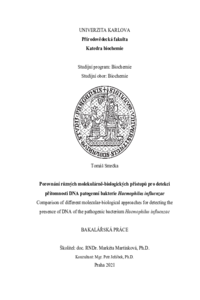Porovnání různých molekulárně-biologických přístupů pro detekci přítomnosti DNA patogenní bakterie Haemophilus influenzae
Comparison of different molecular-biological approaches for detecting the presence of DNA of the pathogenic bacterium Haemophilus influenzae
bachelor thesis (DEFENDED)

View/
Permanent link
http://hdl.handle.net/20.500.11956/151036Identifiers
Study Information System: 231653
CU Caralogue: 9925467877706986
Collections
- Kvalifikační práce [21456]
Author
Advisor
Consultant
Jeřábek, Petr
Referee
Dračínská, Helena
Faculty / Institute
Faculty of Science
Discipline
Biochemistry
Department
Department of Biochemistry
Date of defense
28. 7. 2021
Publisher
Univerzita Karlova, Přírodovědecká fakultaLanguage
Czech
Grade
Excellent
Keywords (Czech)
Haemophilus influenzae, polymerázová řetězová reakce (PCR), izotermální amplifikace DNA pomocí smyček (LAMP)Keywords (English)
Haemophilus influenzae, polymerase chain reaction (PCR), isothermal loop mediated DNA amplification (LAMP)Haemophilus influenzae patří mezi hlavní původce meningitidy a zápalu plic u dětí. Zavedení rychlé, levné a přístrojově nenáročné metody detekce tohoto patogenu by zásadní měrou přispělo k včasné a cílené léčbě pacientů. Rozvoj amplifikačních metod v posledních dekádách umožňuje, krom běžně používané metody PCR, aplikaci alternativních přístupů, mezi něž patří i metoda LAMP. Předmětem zájmu této bakalářské práce proto bylo studium alternativní metody LAMP jakožto nástroje pro detekci Haemophilus influenzae. LAMP metoda byla pro Haemophilus influenzae úspěšně zavedena, nicméně se potýkala s falešnou pozitivitou negativní kontroly v případě delších inkubačních časů. Byla proto navržena optimalizovaná metoda LAMP v přítomnosti deoxyuridintrifosfátu a uracil-DNA glykosylasy. Jejím cílem bylo za pomocí inkorporace uracilů do amplifikovaných úseků DNA a následného odštěpení uracilů působením uracil-DNA glykosylasy pozměnit strukturu amplifikačních produktů, zabránit tak jejich replikaci při případné kontaminaci reakčních směsí při dalších stanoveních a tím snížit riziko falešné pozitivity negativních kontrol na minimum. Byla optimalizována koncentrace deoxyuridintrifosfátu v reakční směsi pro výše uvedené účely. Zásadním přispěním předkládané bakalářské práce k optimalizaci LAMP metody pro detekci...
Haemophilus influenzae is one of the main initiators of meningitis and pneumonia in children. Implementation of fast, cheap and instrumentally accessible method for detection of this pathogen would enable an early and targeted treatment of patients. The development of amplification methods in the last decades enables, apart from commonly used PCR method, application of alternative approaches, such as the LAMP. The focus of this Bachelor thesis was the study (research) of the alternative method LAMP as a tool for detection of Haemophilus influenzae. The LAMP method was successfully implemented for Haemophilus influenzae, however, it has contended with the false positive results of negative control in case of longer incubation times. Therefore, the optimized LAMP method was designed in presence of deoxyuridine triphosphate and uracil-DNA glycosylase. Its aim was to change the structure of LAMP products via the incorporation of uracils to amplified regions of DNA and subsequent removal of uracils with influence of uracil-DNA glycosylase, and therefore prevent their replication during potential contamination of reaction mixtures and consequently reduce the risk of false positive results of negative controls to minimum. The concentration of deoxyuridine triphosphate in reaction mixtures was optimized...
